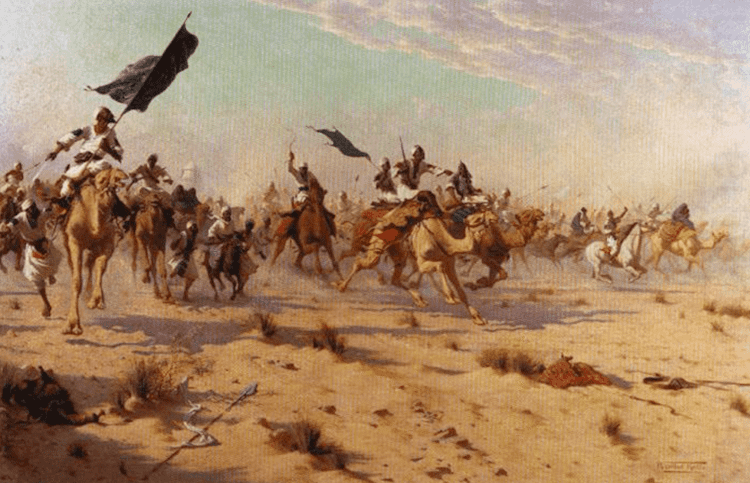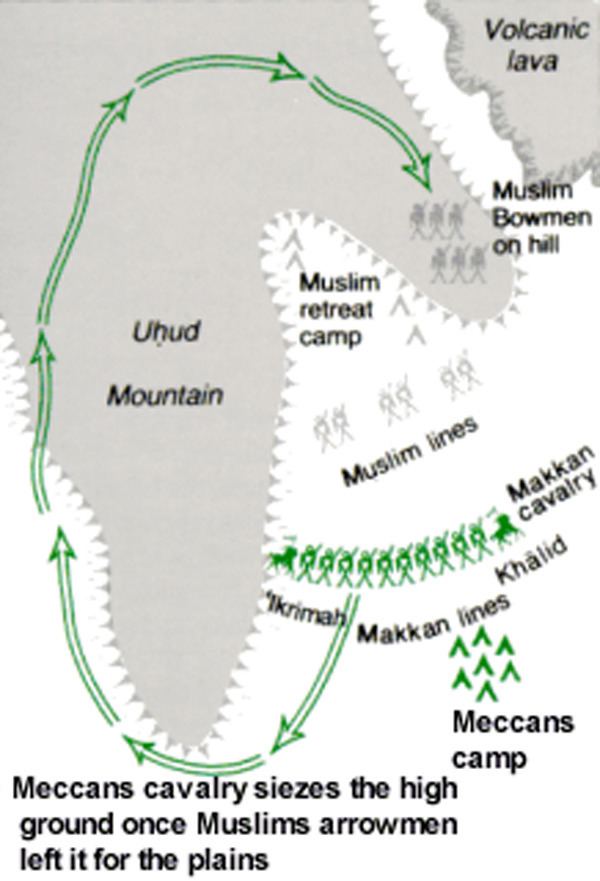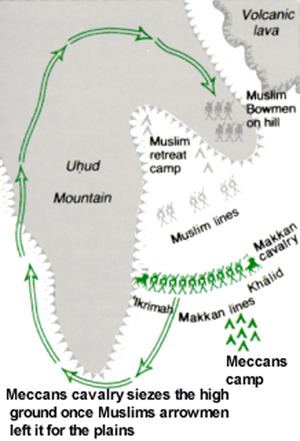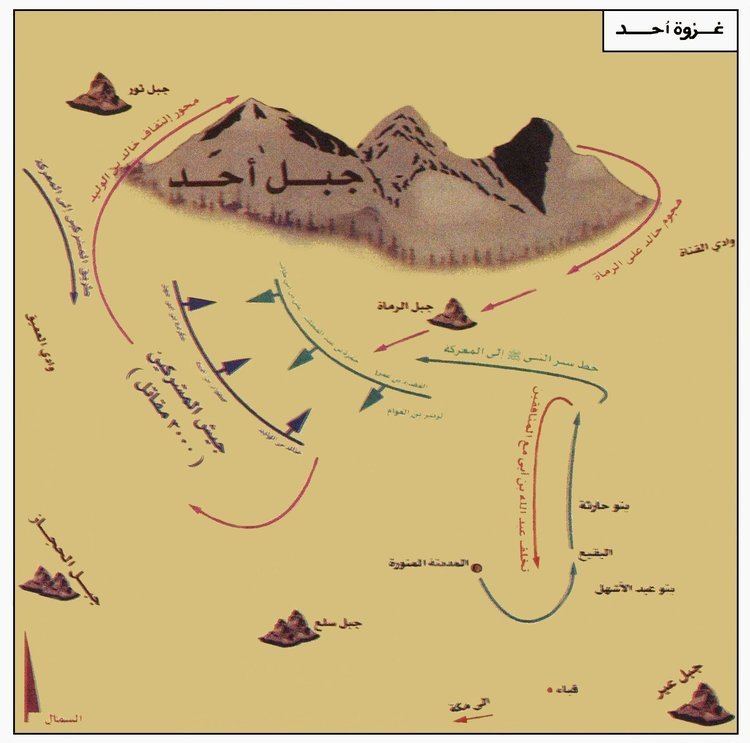70-75 killed 22-37 killed | Date 23 March 625 AD | |
 | ||
Results Stalemate, Muslims receive significant losses, however the Makkans fail to take Madina. Similar | ||
The Battle of Uhud (Arabic: غزوة أحد Ġazwat ‘Uḥud) was fought on Saturday, March 23, 625 (7 Shawwal 3 AH in the Islamic calendar) at the valley located in front of Mount Uhud, in what is now northwestern Arabia. It occurred between a force from the Muslim community of Medina led by the Islamic prophet Muhammad, and a force led by Abu Sufyan ibn Harb from Mecca, the town from which many of the Muslims had previously emigrated. The Battle of Uhud was the second military encounter between the Meccans and the Muslims, preceded by the Battle of Badr in 624, where a small Muslim army had defeated a larger Meccan army.
Contents
- Background
- Reason for battle
- Meccan force sets out
- Encounter at Uhud
- Aftermath
- Muslim reaction
- Further conflict
- Battle of Uhud in warfare
- References
Marching out from Mecca towards Medina on March 11, 625 AD, the Meccans desired to avenge their losses at Badr and strike back at Muhammad and his followers. The Muslims readied for war soon afterwards and the two armies fought on the slopes and plains of Mount Uhud.

Whilst outnumbered, the Muslims gained the early initiative and forced the Meccan lines back, thus leaving much of the Meccan camp unprotected. When the battle looked to be only one step away from a decisive Muslim victory, a serious mistake was committed by a part of the Muslim army, which altered the outcome of the battle. A breach of Muhammad's orders by the Muslim archers, who left their assigned posts to despoil the Meccan camp, allowed a surprise attack from the Meccan cavalry, led by Meccan war veteran Khalid ibn al-Walid, which brought chaos to the Muslim ranks. Many Muslims were killed, and even Muhammad himself was badly injured. The Muslims had to withdraw up the slopes of Uhud. The Meccans did not pursue the Muslims further, but marched back to Mecca declaring victory.

For the Muslims, the battle was a significant setback: although they had been close to routing the Meccans a second time, their breach of Muhammad's orders in favor of collecting Meccan spoils reaped severe consequences. The two armies would meet again in 627 AD at the Battle of the Trench.

Background

Muhammad had preached the religion of Islam in Mecca from 613 to 622. He had attracted a small community of followers, but also drew staunch opposition from the rest of the Quraysh, the tribe that ruled Mecca and to which he belonged. The Muslims fled Mecca in 622 after years of persecution and established themselves at Medina (formerly known as Yathrib; Medina means City). The Quraysh had seized the properties and families of Muslims in Mecca and dispatched caravans to Damascus which the Muslims intercepted and raided. The Meccans sent out a small army to punish the Muslims and stop their raiding. At the Battle of Badr in 624, a small Muslim force defeated the much larger Meccan army.
Many Muslims considered this unexpected victory a proof that they had been favored by God and believed they were assured such victories in the future. A number of the leading tribesmen of Quraysh had been killed at Badr and so leadership passed to Abu Sufyan. He forbade the mourning of the losses at Badr, for he was eager to exact revenge upon Muhammad, vowing to conduct a retaliatory raid on the city of Medina. Several months later, Abu Sufyan accompanied a party of 200 men to the city, obtaining temporary residence with the chief of the Jewish tribe Banu Nadir and learning more of the current situation in Medina. He and his party then left Medina, burning down two houses and laying waste to some fields in fulfillment of his vow. Further skirmishes between the Meccans and the Muslims would occur thereafter.
Reason for battle
The reason for the battle was to retaliate against the Muslims for the Battle of Badr
Meccan force sets out
The following year on March 11, 625, with Abu Sufyan at the helm, the Meccans—anxious to avenge their defeat at Badr—raised another force numbering 3,000 and set out for the Muslim base in Medina. Rather than attacking Medina itself, which was populated by numerous strongholds that would have required long sieges to overcome, they camped on the pastures north of the city, hoping that the Muslims would come out to meet them. According to the early Muslim historian Ibn Ishaq, a number of Meccan women are said to have accompanied Abu Sufyan's army to provide vocal support, including Hind bint Utbah, his wife.
A scout alerted Muhammad of the Meccan army's presence and numbers late on Thursday March 21. The next morning, a Muslim conference of war convened, and there was dispute over how to best repel the Meccans. Muhammad and many of the senior figures suggested that it would be safer to fight within Medina and take advantage of its heavily fortified strongholds. Younger Muslims argued that the Meccans were destroying their crops, and that huddling in the strongholds would destroy Muslim prestige. Muhammad eventually conceded to the wishes of the latter, and readied the Muslim force for battle.
Encounter at Uhud
A group of approximately 1,000 Muslim men set out on late Friday from Medina and managed to circle around the Meccan forces. Early the next morning, they took a position on the lower slopes of the hill of Uhud. Shortly before the battle commenced, 'Abd-Allah ibn Ubayy (the chief of the Khazraj tribe) and his followers withdrew their support for Muhammad and returned to Medina, with reports suggesting Ibn Ubayy's discontent with the plan to march out from Medina to meet the Meccans. Ibn Ubayy and his followers would later receive censure in the Qur'an for this act.
What ye suffered on the day the two armies Met, was with the leave of Allah, in order that He might test the believers,-
And the Hypocrites also. These were told: "Come, fight in the way of Allah, or (at least) drive (The foe from your city)." They said: "Had we known how to fight, we should certainly have followed you." They were that day nearer to Unbelief than to Faith, saying with their lips what was not in their hearts but Allah hath full knowledge of all they conceal.
(They are) the ones that say, (of their brethren slain), while they themselves sit (at ease): "If only they had listened to us they would not have been slain." Say: "Avert death from your own selves, if ye speak the truth."
The Muslim force, now numbering around 700, was stationed on the slopes of Uhud, facing Medina with the rear being protected by the towering mount itself. Before the battle, Muhammad had assigned 50 archers on a nearby rocky hill at the West side of the Muslim camp. This was a strategic decision in order to shield the vulnerable flanks of the outnumbered Muslim army; the archers on the hill were to protect the left flank, while the right flank was to be protected by the Mount of Uhud situated on the east side of the Muslim camp. Protecting the flanks of the Muslim army meant that the Meccan army would not be able to turn around the Muslim camp, and thus the Muslim army wouldn't be surrounded or encircled by the Meccan cavalry, keeping in mind that the Meccan cavalry outnumbered the Muslim cavalry with a 50:1 ratio.
Muhammad ordered the Muslim archers to never under any circumstances leave their positions on the hill unless ordered to do so by him only, he made this order very clear by uttering these words to the archers, "If you saw us prevail and start to take spoils, do not come to assist us. And if you saw us get vanquished and birds eat from our heads, do not come to assist us."
The Meccan army positioned itself facing the Muslim lines, with the main body led by Abu Sufyan, and the left and right flanks commanded by Ikrimah ibn Abi-Jahl and Khalid ibn al-Walid respectively. 'Amr ibn al-'As was named the commander of cavalry and his task was to coordinate attack between the cavalry wings.
The Meccans attacked with their initial charge led by the Medinan exile Abu ‘Amir. Thwarted by a shower of stones from the Muslims, Abu ‘Amir and his men were forced to retire and tend to the camps behind the Meccan lines. The Meccan standard-bearer, Talhah ibn Abi Talhah al-‘Abdari, advanced and challenged the enemy to a duel. Ali (Ali ibn Abi Talib), the young cousin of Muhammad, rushed forth and struck Talhah down in a single blow. Talhah's brother, `Uthman, ran forward to pick up the fallen banner — the Meccan women willing him on with songs and the loud beating of timbrels. Hamza ibn ‘Abd al-Muttalib emerged from the Muslim ranks, bringing him to a similar fate as Talhah. It was their family that was responsible for the Meccan army's standard-bearing, and thus one by one, Talhah's brothers and sons went to retrieve the Meccan banner and fight unsuccessfully, until they all eventually perished.
Following the duels, general engagement between the two armies commenced. Meccan confidence quickly began to dissolve as the Muslims swept through their ranks. The Meccan army was pushed back, and repeated attempts by its cavalry to overrun the left Muslim flank were negated by the Muslim archers. Enjoying the best of these early encounters, the Muslims pierced through the Meccan lines, with victory appearing certain. However, it was the detachment of the Muslim archers, disobeying Muhammad's strict orders to remain stationary, that would shift the outcome of the battle, as they ran downhill to join in the advance and despoil the Meccan camp, leaving the flank vulnerable.
At this critical juncture, the Meccan cavalry led by Khalid ibn al-Walid exploited this move and attacked the remaining minority of Muslim archers who refused to disobey Muhammad's orders and were still positioned on the hill. From there, the Meccans were then able to target and overrun the Muslim flank and rear. Confusion ensued, and numerous Muslims were killed. Most notably was Hamza, who had been thrown down in a surprise attack by the javelin of the Ethiopian slave of Hind, Wahshi ibn Harb. While the Meccan riposte strengthened, rumors circulated that Muhammad too had perished. It emerged, however, that Muhammad had only been wounded—due to missiles of stone which resulted in a gash on his forehead and lip. It is recorded that Ali ibn Abi Talib alone remained, fending off the assaults of Khalid's cavalrymen. According to Ibn Atheer, "The Prophet became the object of the attack of various units of the army of Quraish from all sides. Ali attacked, in compliance with Muhammad's orders, every unit that made an attack upon him and dispersed them or killed some of them, and this thing took place a number of times in Uhud."
After fierce hand-to-hand combat, most of the Muslims managed to withdraw and regroup higher up on the slopes of Uhud. A small faction was cut off and tried to make its way back to Medina, though many of these were killed. The Meccans' chief offensive arm, its cavalry, was unable to ascend the slopes of Uhud in pursuit of the Muslims, and so the fighting ceased. Hind and her companions are said to have mutilated the Muslim corpses, cutting off their ears and noses and making the relics into anklets. Hind is reported to have cut open the corpse of Hamza, taking out his liver which she then attempted to eat. Abu Sufyan, after some brief verbal exchanges with Muhammad's companion, Umar (Umar ibn al-Khattab), decided to return to Mecca without pressing his advantage.
The battle is generally believed by scholars to be a defeat for the Muslims, as they had incurred greater losses than the Meccans. Chase F. Robinson, writing in the Encyclopaedia of Islam, states the notion that "the Muslims suffered a disheartening defeat is clear enough." Other scholars such as William Montgomery Watt disagree, noting that while the Muslims did not win, the Meccans had failed to achieve their strategic aim of destroying Muhammad and his followers; and that the Meccans' untimely withdrawal indicated weakness on their part. The battle is also noted for the emergence of the military leadership and tactical military genius of Khalid ibn al-Walid, who would later become the most famous of all Arab generals during the Islamic expansion era, in conquering the Sassanid Empire and Byzantine held Syria.
Aftermath
Muhammad and the Muslims buried the dead on the battlefield, returning home that evening. The Meccans retired for the evening at a place called Hamra al-Asad, a few miles away from Medina. The next morning, Muhammad sent out a small force to harry the Meccan army on their way home. According to Watt, this was because Muhammad realized that a show of force was required to speed the Meccans away from Medinan territory. The Meccans, not wanting to be perceived as being chased away, remained nearby for a few days before leaving.
Muslim reaction
For the Muslims, the battle held a religious dimension as well as a military one. They had expected another victory like at Badr, which was considered a sign of God's favor upon them. At Uhud, however, they had barely held off the invaders and had lost a great many men. A verse of the Qur'an revealed soon after the battle cited the Muslims' disobedience and desire for loot as the cause for this setback:
Allah did indeed fulfil His promise to you when ye with His permission Were about to annihilate your enemy,-until ye flinched and fell to disputing about the order, and disobeyed it after He brought you in sight (of the booty) which ye covet. Among you are some that hanker after this world and some that desire the Hereafter. Then did He divert you from your foes in order to test you but He forgave you: For Allah is full of grace to those who believe.
According to the Qur'an, then, the misfortunes at Uhud — largely the result of the rear guard abandoning their position in order to seek booty — were partly a punishment and partly a test for steadfastness. Firestone observes that such verses provided inspiration and hope to the Muslims, sacralizing future battles that they would experience. He adds that rather than demoralizing the Muslims, the battle seemed to reinforce the solidarity between them.
Further conflict
Abu Sufyan, whose position as leader was no longer undisputed, set about forging alliances with surrounding nomadic tribes in order to build up strength for another advance on Medina. The success of the Meccans' rousing of tribes against Muhammad reaped disastrous consequences for him and the Muslims with two main losses: one was where a Muslim party had been invited by a chieftain of the Ma'unah tribe, who were then killed as they approached by the tribe of Sulaym; while the other was when the Muslims had sent out instructors to a tribe which stated it wanted to convert to Islam — the instructors had been led into an ambush by the guides of the would-be Muslim tribe, and were subsequently killed. Soon thereafter, Muhammad became convinced that the Jewish tribe Banu Nadir harbored enmity towards him and were plotting to kill him. The Banu Nadir were expelled from Medina after a fifteen-day siege, with some relocating to the oasis of Khaybar and others to Syria. Abu Sufyan, along with the allied confederate tribes, would attack Medina in the Battle of the Trench, two years after the events at Uhud (in 627).
Battle of Uhud in warfare
Though strategically indecisive, the conduct of the battle was sufficient proof of the military awareness of the Arabs even before their campaigns in Persia and Syria. The basic assumption that Arabs were generally raiders and learned warfare from the Persians and Syrians is proved wrong here. Abu Sufyan made full use of his cavalry by deploying them as two mobile wings. The infantry based centre provided the base upon which the cavalry would operate. He intended to pull the celebrated "Double Envelopment" maneuver. He deployed his forces in the same manner as a Persian or Byzantine general would have done.
Muhammad on the other hand showed his ability as a general by choosing the battlefield of Uhud. He decided according to the will of Muslims to fight in open country but he was aware of the superior mobility of the Meccans. He knew an encounter in open country would expose the infantry wings to envelopment, so to neutralize the Meccan mobility factor, he decided to hold high ground with Mount Uhud in their rear, which provided security from any attack from the rear. Moreover, as the front was of approximately of 800 to 900 yd (730 to 820 m) and on one flank he rested Mount Einein and on other flank were the defiles of Mount Uhud so in military language he refused both wings to the Meccan cavalry. The only approach from which they could be taken from the rear was protected by the deployment of archers. This battle is a specimen of how an infantry based entity should fight against a cavalry dominated arm. The comparison of this battle with the Battle of Guadalete fought by Tariq ibn Ziyad against the Visigothic Kingdom is indeed striking.
